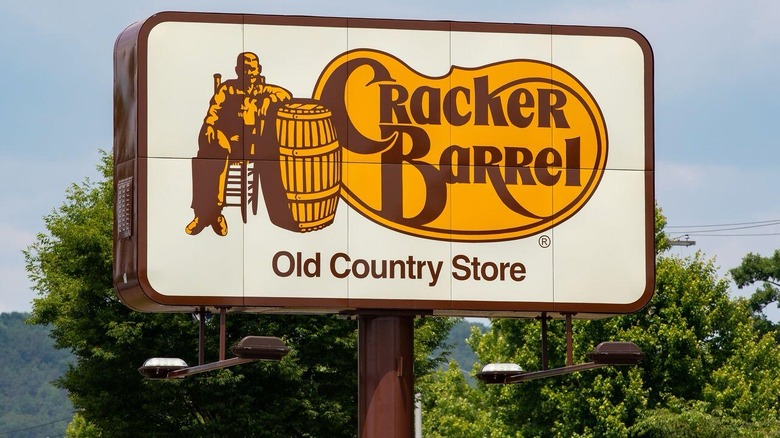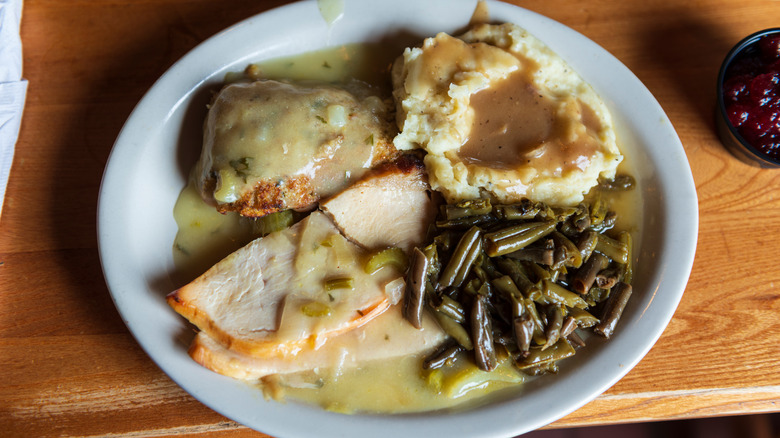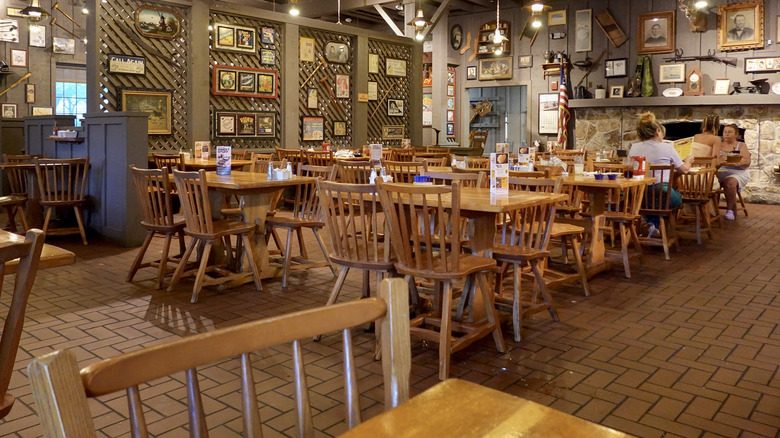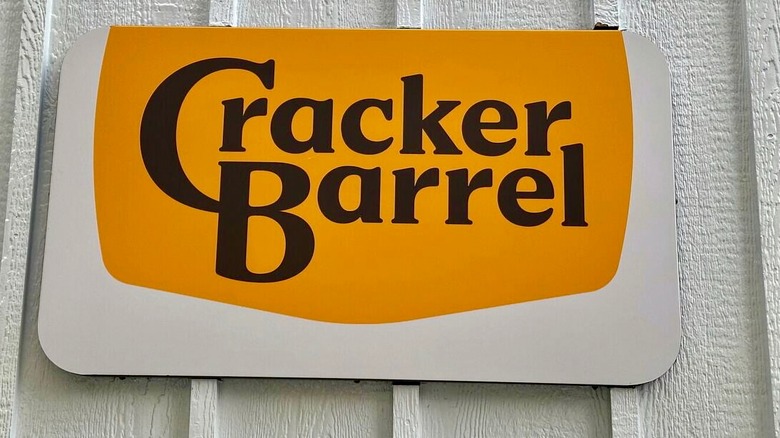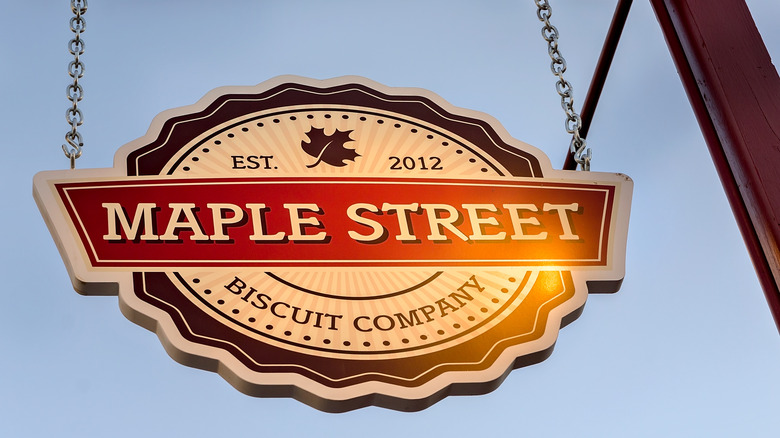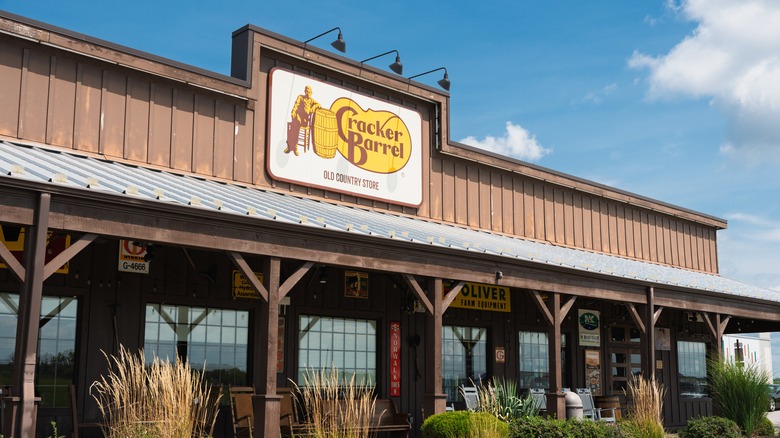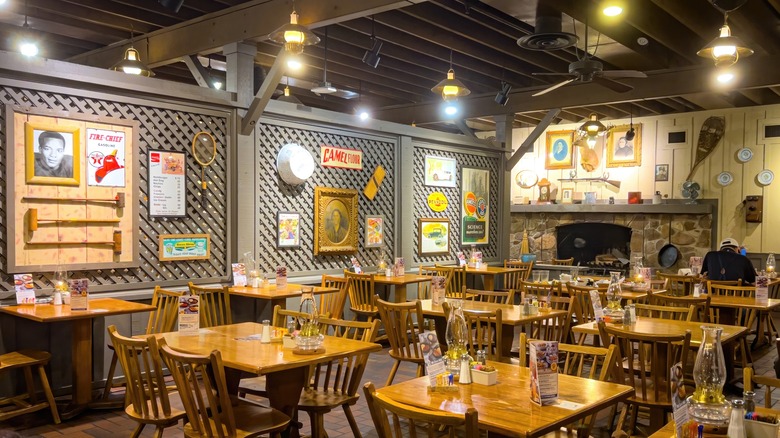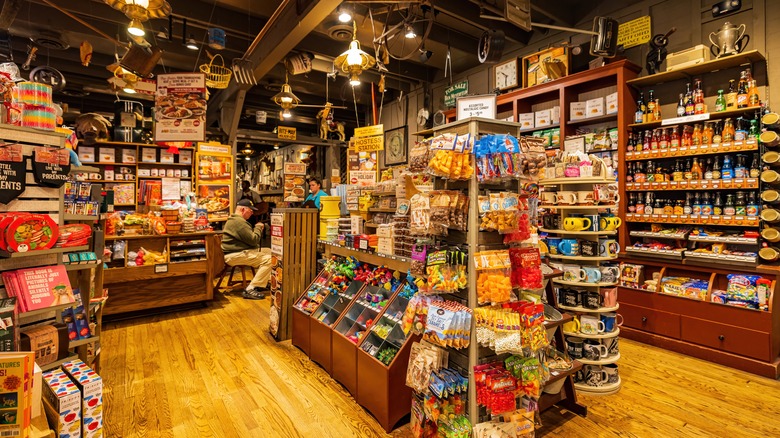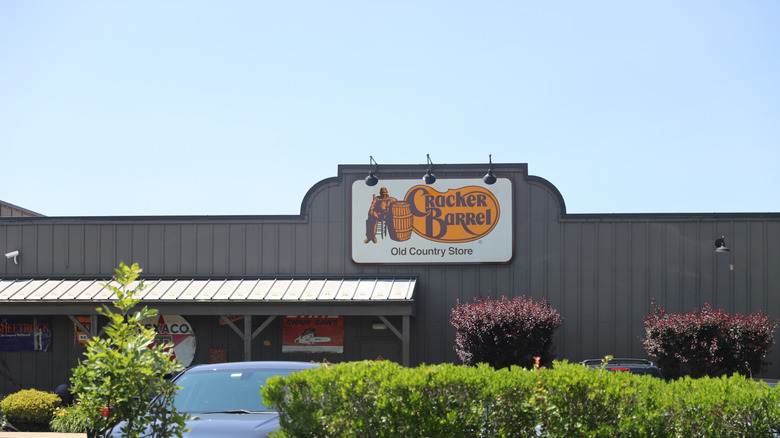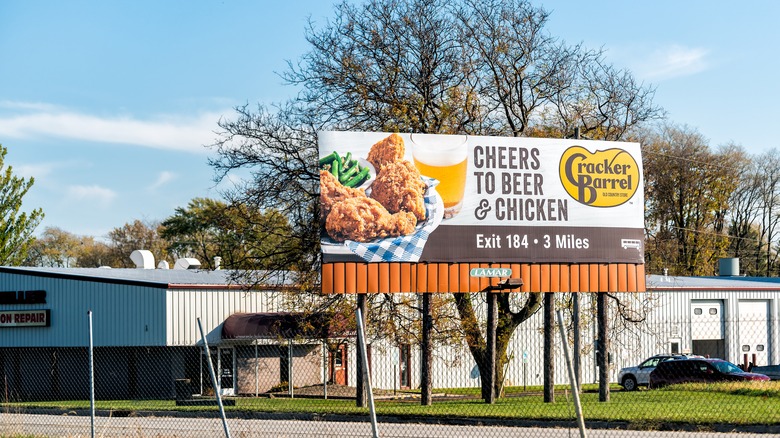9 Big Reasons Cracker Barrel Is Struggling
The COVID-19 pandemic was brutal on businesses everywhere, but not many felt it harder than casual dining spots. With in-dining suspended, commodity prices skyrocketing, and folks cutting down on discretionary spending, the floor dropped out from under the already floundering segment. Grimmer times lie ahead, unfortunately. About half a decade later, casual dining is still scrambling to get back on its feet, with a majority of heavy hitters still battling rough headwinds. Officially and very publicly joining their ranks is Cracker Barrel, the Lebanon, Tennessee-based chain that grew nearly 600 units strong on a mix of old-school country décor and a Southern comfort–centric menu.
Like many of its peers, Cracker Barrel had been pushing against brutal headwinds long before the recent pandemic. The chain's revenue had already plateaued by 2019, with revenue from restaurant sales staying afloat only through price hikes. Retail sales, once a reliable cushion, had flatlined. So when COVID-19 hit, the chain had little insulation. The issues simmering under the surface erupted almost in unison: Revenue tanked, foot traffic dwindled almost to nothing, and like rivals Ruby Tuesday and Red Lobster, Cracker Barrel slid into a downturn unlike anything in its half-century history. So, what exactly went wrong? Let's dive into the perfect storm of problems seemingly intent on dragging this iconic old-school chain down, from price hikes, declining investor confidence, and missed expansion bets to, yes, that controversial logo change.
Charging more despite declining food quality
Aggressive promotional campaigns and flashy billboards aside, nothing spurs brand loyalty quite like holding the line on both quality and price even under severe financial pressure. The inverse is also true: Nothing gives you a worse reputation than padding menu prices (hi Outback), especially in a market flooded with alternatives. But while fast casual chains were turning to promotional bundles and value menus to weather the pandemic, Cracker Barrel took a different route: aggressive price hikes.
The chain was already losing steam prior to the pandemic, with guest traffic dropping 1.9% between 2017 and 2018 and another 0.7% the following year, per Cracker Barrel. Menu prices were quietly inching up, too, rising 2.3% on average between the fourth quarter of 2018 and the same period in 2019. With in-dining suspended and commodity and labor costs soaring during COVID-19, Cracker Barrel leaned even harder on price hikes to offset waning traffic. Menu prices rose by an average of 1.8% in 2020, per the brand, another 2.1% in 2021, 5.9% in 2022, 8.6% in 2023, and 4.9% in 2024. By mid-2025, Cracker Barrel menu prices had risen by almost 35%, which, while well below the industry average of 39%, still outpaced the national inflation rate by miles.
Even as pricing continued upward, quality remained subpar. Case in point: Those woefully misshapen chicken pot pies. "Taste like everything comes straight out of a can now," one Redditor griped. "Tasteless with no home cooking feel to it. Mushy beans from a pressure cooker. Worst corn muffins ever tasted. They would be better off to buy jiffy muffin mix, theirs are so bad and never browned. They give Southern cooking a bad name."
Quality sentiments remained tepid even after menu overhauls. Aside from padding prices, Redditors blamed the overhauls for reducing serving sizes and whittling down food quality even further than it'd already been. "These new changes have affected the menus. Prices cost more, servings are smaller, items have been changed and there's a noticeable drop in quality. One year ago this was non existent," one Redditor wrote.
Shrinking customer base
Whether through targeted campaigns or just happenstance, restaurants sometimes end up appealing to certain generations more than others. While some have managed to transcend the generational gap, Cracker Barrel is not one of them. This one is decidedly a Boomer favorite. The dependable, Southern comfort–centric menu, the old country nostalgia; the only thing missing is a Fleetwood Mac cover band, and you've got Boomer heaven.
That's why the chain grew so rapidly between the late 1990s and early 2000s, back when Boomers basically ruled the American economy. But there's only so far riding the Boomer wave will get you; just ask landlines. By the late 2010s, most Boomers had hit retirement, which meant incomes began shrinking and discretionary spending was shoved to the back burner.
With its core demographic now trailing the market, Cracker Barrel — like its forerunner Howard Johnson in the 1990s — began floundering. New unit growth had mostly plateaued by the late 2010s. Foot traffic was dwindling. Retail sales were barely scraping by. And while price hikes kept top-line numbers steady, it was clear that Cracker Barrel had outlived its heyday.
It didn't help that the chain kept hiking prices all the while making almost no effort to cater to its aging base's changing needs. Menu items remained as carb-heavy as ever, despite diet restrictions being prevalent among older diners. This didn't go unnoticed by older patrons, at least according to Reddit. Some began avoiding the chain outright. "Both my husband and I are seniors, thank you, and we only eat there on the very rare occasions we're traveling on an interstate and there's nowhere else on earth to eat," one Redditor wrote. "There is NOTHING healthy or fresh on their menu. It is all unhealthy, pre-made Southern food. And no amount of their re-branding or re-decorating will help."
Branding misfire alienated loyal fans
Every restaurant that's lasted more than a decade has a pretty specific differentiator that sets it apart from the competition. For Cracker Barrel, that special sauce was being a living time capsule of small-town American life. The front porch dotted with rocking chairs, the old country store gift shops, the Southern-style menu items, and the iconic logo with Uncle Herschel leaning on a barrel (of crackers, presumably).
But with foot traffic dropping during COVID-19 and barely recovering even with waning inflation post-pandemic, it became clear that running on nostalgia alone wouldn't cut it. So, like Ruby Tuesday in the early 2010s, Cracker Barrel began fiddling with its special sauce, kickstarting a $700 million rebranding campaign intended to fast-track the brand back to relevancy. First on the agenda was ditching the old country rustic décor for a more modern, minimalist look. Social media grumbled somewhat, but CEO Julie Felss Masino pointed to upticks in foot traffic at the remodeled units as signs the tides had turned for the better.
Then came the logo. Giving a few units a minimalist facelift was one thing, but scrapping Uncle Herschel entirely? That couldn't stand. Social media erupted, with everyone from conservative commentators to the Pentagon breathed fire on the company for stripping the brand's character. "Aside from the fact that it sucks that they made Cracker Barrel look like an app, can someone explain to me what the shape the original logo is in was supposed to be? It looks like a bean or something," one Redditor griped.
By the time Masino announced a rollback, the company's stock value had already plunged roughly 13%, notes Reuters. Even with the rollback, a turnaround was still far in the offing. Foot traffic continued to decline, falling a startling ~8% post-logo change. The stock value didn't rebound either, dropping an additional ~3% just a day after the rollback. By the time the dust settled, about $200 million of the company's market capitalization had gone down the drain; along with it, Masino's ambitious $700 million "All the More" rebranding campaign.
Underperforming side businesses
As can be gleaned from the running count of bankruptcy filings, the restaurant industry is pretty keen on shedding dead weight. And it's not just mom-and-pop outlets hitting a nosedive anymore; even heavy hitters like KFC and Texas Roadhouse have been scrambling to survive. That's why a lot of chains have been diversifying, carving out territory in booming market spaces, if only to cushion their main operations against downturns. Cracker Barrel had already cracked this code with its retail arm, which, up until 2016, accounted for roughly a quarter of the company's yearly revenue. But with retail sales losing steam in 2016, it was time to start exploring alternatives.
First up was setting up the fast-casual concept Holler & Dash Biscuit House. This wasn't necessarily an ill-advised move, considering the sector was growing. Holler & Dash saw a promising start, growing to seven units in three years. Though given that shareholders were grumbling all through the expansion, things couldn't have been going well revenue-wise. But rather than shake off the struggling brand, Cracker Barrel doubled down, purchasing fast casual breakfast chain Maple Street Biscuit Company for $36 million in 2019, presumably to consolidate Holler & Dash under a stronger brand. The company continued to diversify through 2019, dropping an additional $140 million on a non-controlling stake in eat-ertainment chain Punch Bowl Social that same year.
Unfortunately, none of these investments panned out as expected. Maple Street Biscuit was forced to shutter 14 locations in September 2025 after years of poor performance. Punch Bowl Social, on the other hand, filed for Chapter 11 just months into the pandemic, taking about $132.9 million of Cracker Barrel cash with it. And despite being a seasonal décor goldmine, the chain's retail concept remained on the decline, with comparable retail sales cratering by 17.1% in 2020, recovering briefly in 2021 and 2022, before dropping 0.4% in 2023 and another 5.5% in 2024.
Declining investor confidence
With the restaurant industry being as cutthroat as it is, struggles are pretty much inevitable. But that doesn't mean struggling chains don't have a few safety nets; the biggest of which is investor confidence. A lot of chain restaurants were near goners before getting a helping hand from investors. So, naturally, losing investor confidence is a pretty surefire sign that a brand's struggles might be protracted and, to an extent, irreversible. Unfortunately, Cracker Barrel might not have as strong a safety net on this front as it once did.
The brand's most dissatisfied investor is likely Sardar Biglari, owner of Biglari Holdings. Biglari set his sights on Cracker Barrel back in 2011, purchasing about $241.1 million worth of shares, per Fortune, and almost immediately thereafter embarking on what would become a 14-year proxy battle aimed at taking ownership of the brand. While shareholders have so far managed to fend off his takeover attempts, his long-winded criticism has only amplified Cracker Barrel's struggles, which doesn't exactly inspire confidence in new investors. It also doesn't help that Cracker Barrel's dividend payouts have grown increasingly unattractive to cash-hungry investors.
But Biglari's aggressive activism aside, there are broader signs that investor confidence is slipping on a much broader scale. Cracker Barrel shares have lost roughly 70% of their value since peaking in 2021, signaling that investors aren't lining up to plug money into the brand anymore. Investors were especially desperate to jump ship amid the branding misfire. Roughly $250 million worth of shares changed hands in days, placing Cracker Barrel 348th in the market by trading volume; alarmingly high for what's typically a slow-moving stock. Investors grew even more frantic after the chain's fourth-quarter report, which projected 2026 revenue at between $3.35 billion and $3.45 billion, well below the expected $3.52 billion. Stock value plunged a startling 10% almost immediately after the report went public, marking yet another steep drop in a worrying trend of declining share value.
Struggles attracting younger diners
With menu prices soaring and no senior discounts in sight, it's highly likely that Cracker Barrel will keep losing traction among older patrons. This might not be such a huge deal if the chain had a healthier age mix, but its customer base is heavily skewed toward older diners. This demographic makes up about half of Cracker Barrel's customer base, while Millennial and Gen-Z diners combined make up only about a quarter.
Multiple attempts have been made to even the balance over the years. And while there have been modest upticks from efforts like the beer and wine program launched in 2022, it hasn't been nearly enough to make up for dwindling visits from older patrons. The chain's also had quite a number of missteps that have more or less eroded any gains. Remodeling its restaurants, for instance — intended to draw in younger diners — only sparked outrage among loyalists. The ensuing logo debacle made things even worse, deepening negative sentiment and alienating younger audiences further. The brand's response to the backlash didn't help much either. Rolling back the $700 million planned remodel shoved it right back to its nostalgia shtick, which was already a non-starter with younger diners.
Tariff pressures and industry-wide economic downturn
Granted, Cracker Barrel's got a unique mix of problems. But like every struggling chain out there, it's been hit hard by macro stressors beyond its own missteps. The casual dining sector has been treading water for quite some time, with rising commodity and labor costs squeezing already tight margins. Price hikes, while inevitable, have only dragged down already-strained foot traffic, sending revenue tumbling. Sales growth for the top players in the sector dropped from 4% 2015 to a startling 1.4% in 2016, notes FastCasual. The sector saw a modest rebound in 2018, but the COVID-19 pandemic quickly erased those gains, with sales plunging ~26% in 2020 compared to 2019.
The industry has clawed its way back since then, with chains like Olive Garden and Applebee's gaining ground and even edging out some quick-service rivals by 2025. But Cracker Barrel's road to recovery might not be quite as straightforward. Diversifying into retail has previously insulated the chain from industry shakeups, giving it a dependable revenue cushion to fall back on during tough times. But it might prove a liability under new tariffs. Because a huge chunk of its retail inventory is sourced overseas, Cracker Barrel's tariff exposure is far greater than its peers. While others in the industry expect little to no margin pressure from tariffs, the chain is bracing for a $5 million shock to EBITDA in the fourth quarter of 2025 alone. And while strategies like trimming SKU count, switching to local suppliers, and renegotiating supplier contracts might bring that number down in the long run, taking such a huge hit can't bode well, especially considering its retail arm has been struggling for nearly a decade.
Launching an expensive remodel despite declining revenue
Cracker Barrel's revenue might have taken its biggest hit during the COVID-19 pandemic, but that doesn't mean everything was biscuits and gravy prior. Comparable restaurant sales hit a low of 2.2% in 2016, down from 5.1% in 2015, notes Cracker Barrel. Growth remained nominal at best through 2017 and 2018, with only a slight bump in 2019; right before the pandemic cratered comps by 18.9%, per the brand.
Post-pandemic recovery was slow, with traffic inching up steadily but never quite stabilizing to pre-pandemic levels. Though largely driven by price hikes, sales did recover somewhat, with comparable restaurant sales rising 8.4% in 2021, another 15.0% in 2022, and 6.3% in 2023. But just as a rebound seemed in the offing, Cracker Barrel launched a $700 million revamping campaign; well-intended, sure, but pretty ambitious for a chain already wrestling with revenue. Dividend payouts were slashed from $1.30 to $0.25 to free up capital, according to Investopedia; a move that didn't exactly sit right with Wall Street. Shares tumbled more than 12% intraday following the announcement, tipping the chain's already faltering market value.
All that might've been written off as growing pains if the remodel had actually boosted sales. But practically every initiative under the plan spurred backlash. By the time CEO Julie Masino called time, foot traffic had dropped by 8% and was projected to fall another 4% to 7% by year's end. Also down the drain was a chunk of that $700 million, since half-finished renovations had to be scrapped and units reverted to their original layouts.
Minimal marketing effort despite brutal competitive pressure
You've probably never seen a Cracker Barrel commercial, and there's a good reason for that. For one, being located off major highway exits is pretty solid advertising on its own. And that's before you add decades of near-ubiquitous presence and a dependable customer base. For a long time, all it took for the chain to stay top of mind were a few well-placed billboards. But times have changed. Legacy channels like billboards aren't the safe bets they used to be. Traffic from long-haul truckers and interstate highway commuters isn't as reliable anymore, either.
Rather than adjust to keep pace with the times, Cracker Barrel has stayed stuck in its ways. The chain often pushes advertising to the back burner, especially when other administrative priorities take center stage. In the fourth quarter of 2023, for instance, the chain diverted a portion of its advertising budget to labor; a decision that later spurred — at least in part — a significant drop in foot traffic. Even when it does spend, it's minimal, most of it going to billboards. In 2024, for instance, the company spent $112,793 on advertising, up roughly $23,000 from the previous year. The brand also has a near-invisible online presence and barely attempts to communicate value to its customers. Meanwhile, peers like Olive Garden are constantly pushing promotions and limited-time offers across social media.
The sad part is that Cracker Barrel doesn't have the privilege of not advertising; at least not anymore. Gone are the days when one or two heavy-hitters ruled the casual dining roost. Casual dining chains have exploded over the past couple of decades. This rapid expansion, combined with the segment's waning dominance, has weakened per-unit volumes across the board. Now, more than ever, chains have to fight tooth and nail to stay relevant. Those that fail to communicate value risk losing ground to the glut of competitors and ending up just another in the growing pile of has-beens.

